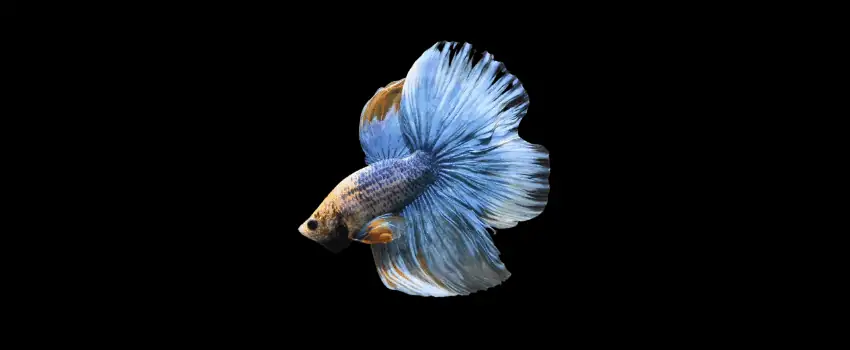Betta fish color patterns fall into three categories:
- Solid
- Bicolor
- Multicolor
Solid and bicolor bettas are common because breeding them is easy compared to multicolor bettas.
Multicolor bettas are the most popular due to the wide range of color patterns they can show.
Many multicolor bettas have vivid colors of red, blue, and yellow.
But there are pastel versions of multicolor bettas available on the market today.
One of these pastel variations is the grizzle betta.
Grizzle bettas were once considered a fault in the pastel bettas.
Breeders took grizzle bettas to new heights through selective breeding for their color patterns.
So, what is a grizzle betta? And how are they different from other multicolored bettas?
Table of Contents
What Is a Grizzle Betta?

Grizzle bettas are best described as pastel bettas with random splotches or iridescent colors.
The body of grizzle bettas is usually a pastel blue, pink, or green.
There is usually only one other color present in random flecks on the body and fins. But it is not uncommon for many different colors in these spots.
Grizzle bettas must have at least two distinct iridescent colors on the body and fins.
The ideal breeding standard for grizzle bettas is 50% iridescent coloring and 50% opaque or pastel coloring on the body.
Mutations in the pastel genes cause these flecks of color on solid pastel bettas.
Some betta hobbyists believe the grizzle betta also has marble genes. This topic is usually debated because of the different characteristics of grizzle and marble bettas.
Grizzle bettas have a soft color spray gradient effect. The colors blend at the edges as if painted on the betta with a brush.
This two-tone soft color spray effect gives grizzle bettas the appearance of a watercolor painting.
Bettas with marble genetics have more distinct lines separating their many colors.
The mutated pastel genes are also more stable than marble genes.
Marbled bettas can change color many times during their life.
But grizzle bettas maintain more stable color patterns.
Are Grizzle Bettas Rare?
Grizzle bettas are rarer than bettas with marbled patterning.
The color patterns on grizzle bettas are stunning. But many betta owners see these patterns as a fault on a regular pastel betta.
Due to this stigma, grizzle bettas are not as popular as solid pastel bettas.
Breeding grizzle bettas is a complex task because they rely on mutated genes. This increases the rarity of these beautiful fish.
The most common tail type found in grizzle bettas is the crowntail. They are also available in halfmoon and plakat varieties.
Often, breeding for a specific tail type gets overshadowed by breeding for the grizzle color pattern.
The Average Cost of a Grizzle Betta
The average cost of a grizzled betta is between $16-$35, depending on the fin and tail type.
Rare grizzle varieties like the over halfmoon tail type or elephant ear betta cost a bit more at $50 to $85.
Very few pet stores sell grizzle bettas. But several online breeders have them available.
Many grizzle bettas online are from Thailand breeders.
You must also account for shipping costs when buying bettas online.
Always check an online breeder’s shipping and return policies. Shipping is very stressful for bettas, and there is a chance they can die in transit.
The Breeding History of Grizzle Bettas
The exact origin of grizzle bettas is not known.
Breeding grizzle bettas is a difficult process. This is because their physical appearance depends on mutated genes.
This mutation takes place in the iridescent layer composition, which is the top color cell layer in domestic betta fish.
Let’s take a quick look at the different color layers in domestic betta splendens.
1. Iridescent
The iridescent layer is the top layer of color cells in betta fish.
This layer is dominant over all other colors and produces green, royal blue, and steel blue iridescence.
2. Black
The black layer carries melano genes, which control three traits:
- Cambodian
- Blonde/bright
- Melano (black)
Cambodian genes prevent dark pigments. Bettas with this gene usually have flesh-colored bodies and red fins.
Blonde/bright genes limit the amount of black in bettas. These genes also create a pastel color in iridescent bettas.
Melano genes are responsible for the dark pigments in black fish. Female bettas with melano genes are usually infertile.
3. Red
Red layer cells control the following traits in bettas:
- Extended red
- Reduced red
- Non-red
- Variegated fins
The first three traits determine how much red color bettas have.
Extended red makes the entire body and fins red.
Reduced red creates bettas with dark body colors and red fins.
Non-red genes suppress the red pigment and produce a yellow color.
Butterfly bettas have the trait for variegation in their fins. This trait is present in various patterns and intensities in other betta types.
4. Yellow
Despite the name, this layer does not control yellow coloration in bettas.
Yellow bettas have non-blue genes in the iridescent layer, Cambodian genes, and non-red genes.
This yellow layer may control the opacity of a betta’s colors.
How These Layers Come Together in Grizzle Bettas

There are three visual guidelines grizzle bettas must follow:
- Single base color (non-black or red)
- Colors in a gradient fashion on the body and fins
- Presence of two colors
In grizzle bettas, there are a lot of cells in the iridescent layer. This creates iridescence on the body and fins.
These iridescent cells are usually from the green or steel blue variety rather than the royal blue.
Blonde/bright genes on the black layer create the pastel color in grizzle bettas. Grizzle bettas lack any melano genes from this layer.
Variegated genes from the red layer give grizzle bettas their gradient coloration. The different colors in grizzle bettas have a blended effect compared to marbled bettas.
Many grizzle bettas have opaque colors, which come from the yellow layer.
A true grizzle betta must have at least 50% opaque or pastel coloring.
If you breed a Cambodian betta with an iridescent betta, there is a chance for grizzle offspring.
Breeding a grizzle betta with a Cambodian color type can produce offspring with both color types.
When you breed two grizzle bettas, you get mostly grizzle offspring with some having only the pastel trait.
Crossing grizzle bettas with marble bettas can result in offspring with marble and non-marble traits.
Do Grizzle Bettas Change Color?
True grizzle bettas have a stable color pattern.
This is because their color pattern develops from mutated blonde/bright genes responsible for the pastel color.
But this does not mean grizzle bettas cannot also carry the mutating marble genes as well.
Pastel and marbling genes are both recessive traits.
If a grizzle betta has more of the marbling genes than the pastel genes, it inherits marble traits.
Grizzle bettas with the marble genes still have the gradient coloring due to the variegated trait.
But these grizzle/marble bettas can change colors over time.
The color-changing effect in grizzle bettas with marble genes is subtle compared to the major shift most marble bettas go through.
Mutated pastel genes usually do not keep mutating during a betta’s life.
This differs from marble genes, which continue mutating throughout a betta’s lifetime.
The rate of mutation in marble genes varies. A betta with marble genes may only change color 1-2 times or several times during its lifespan.


